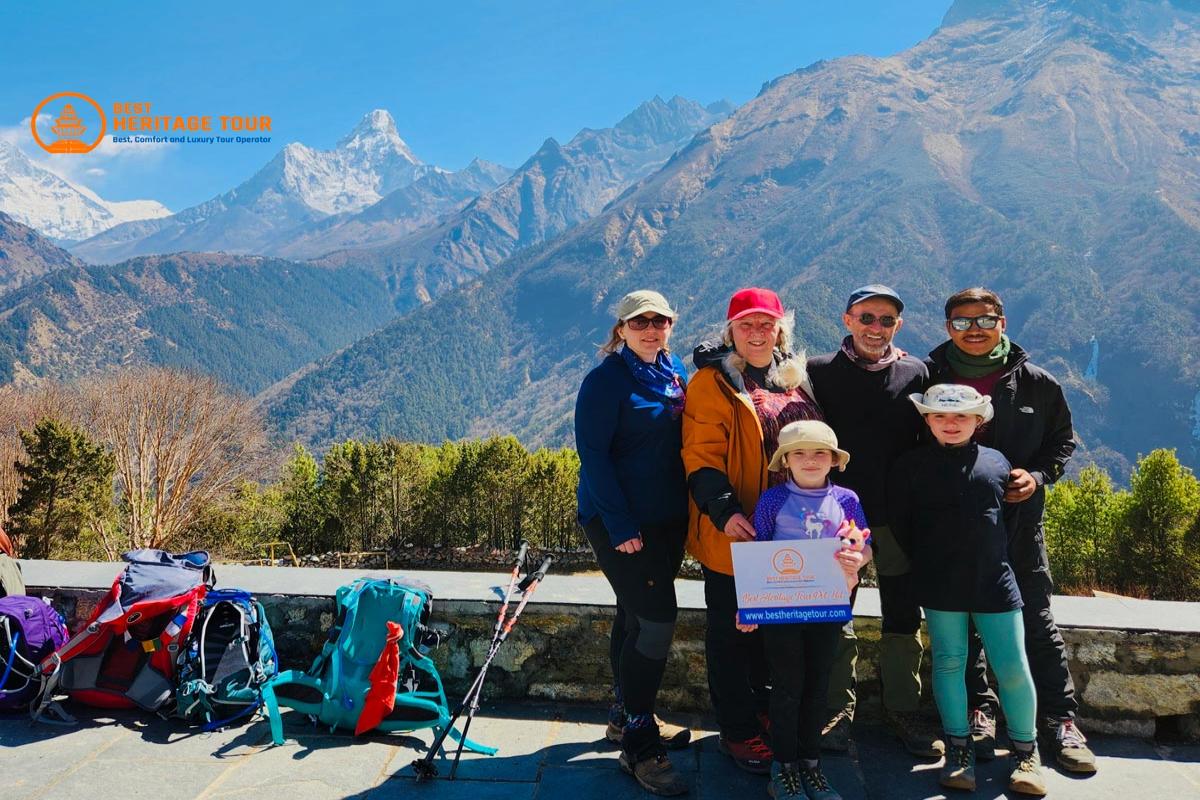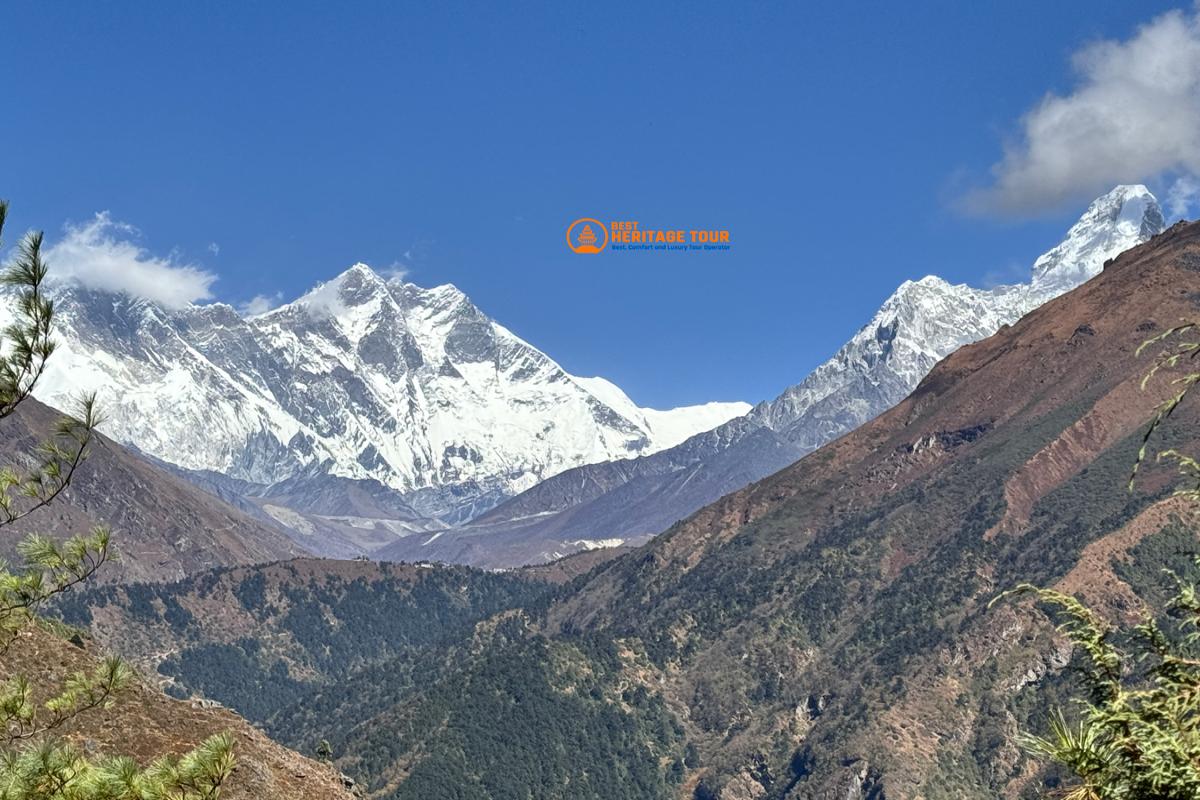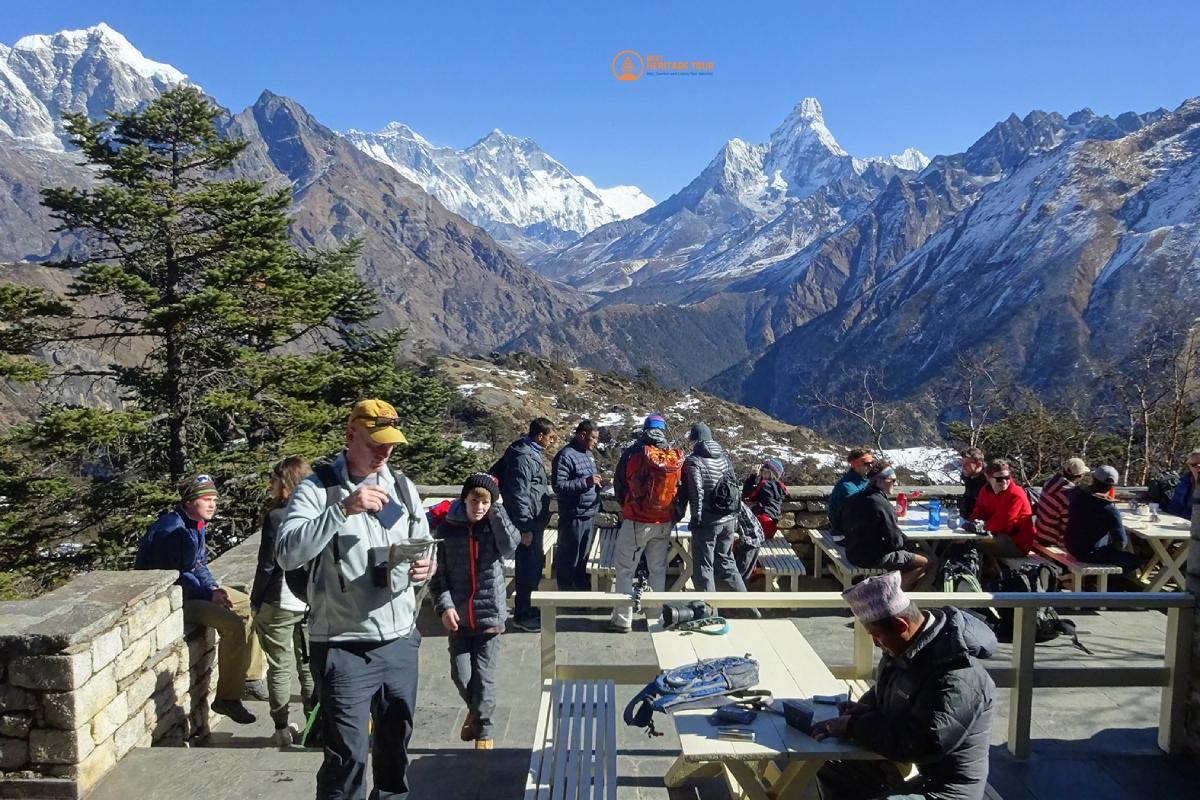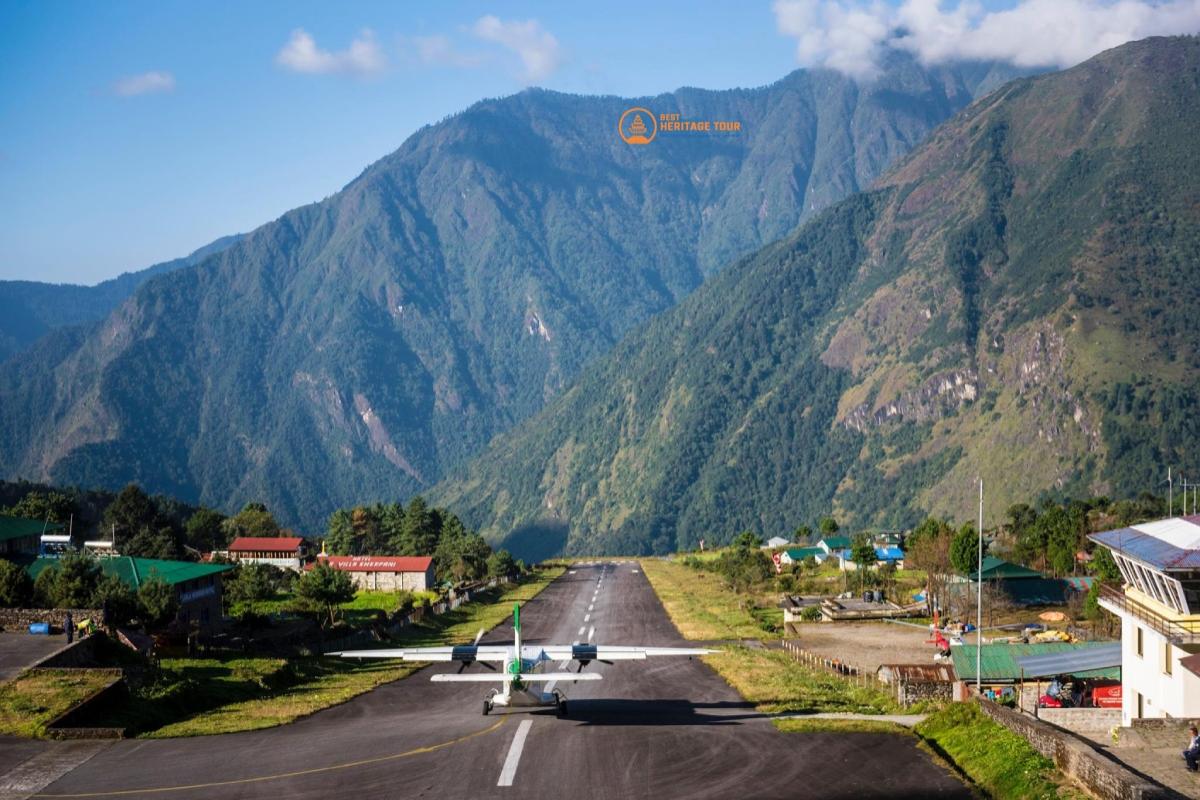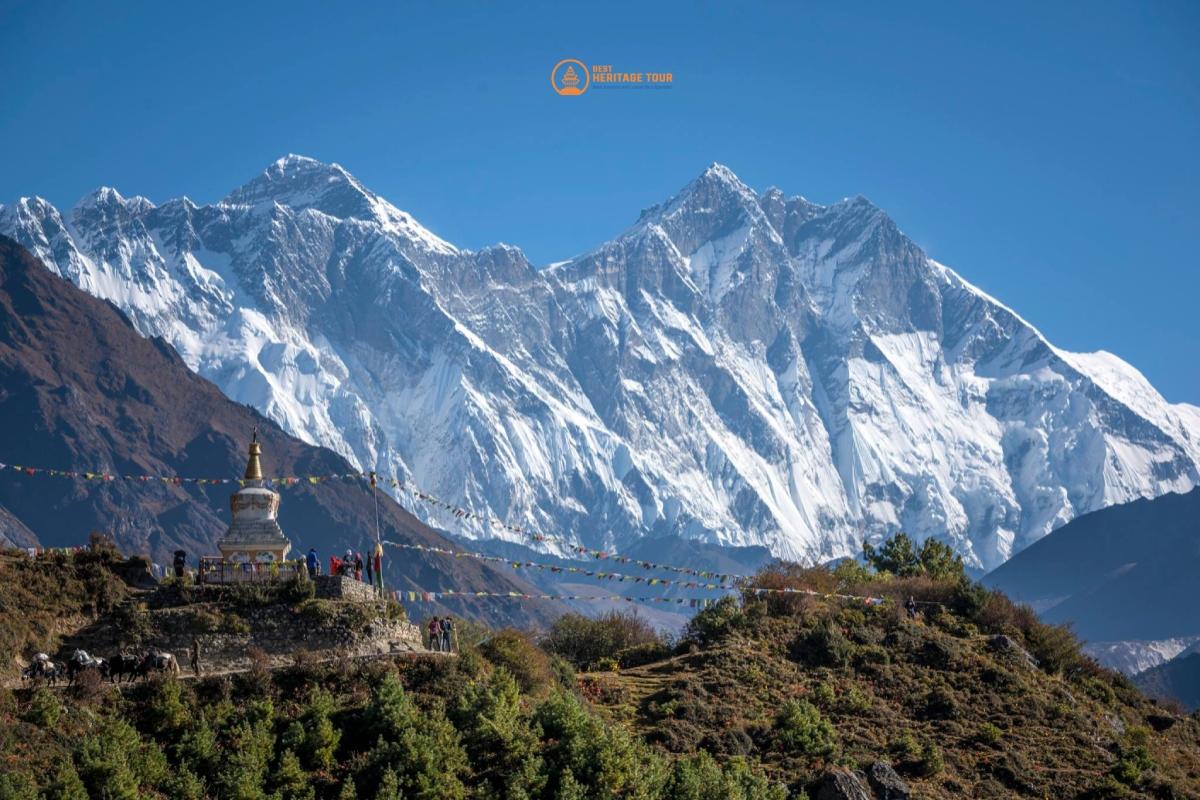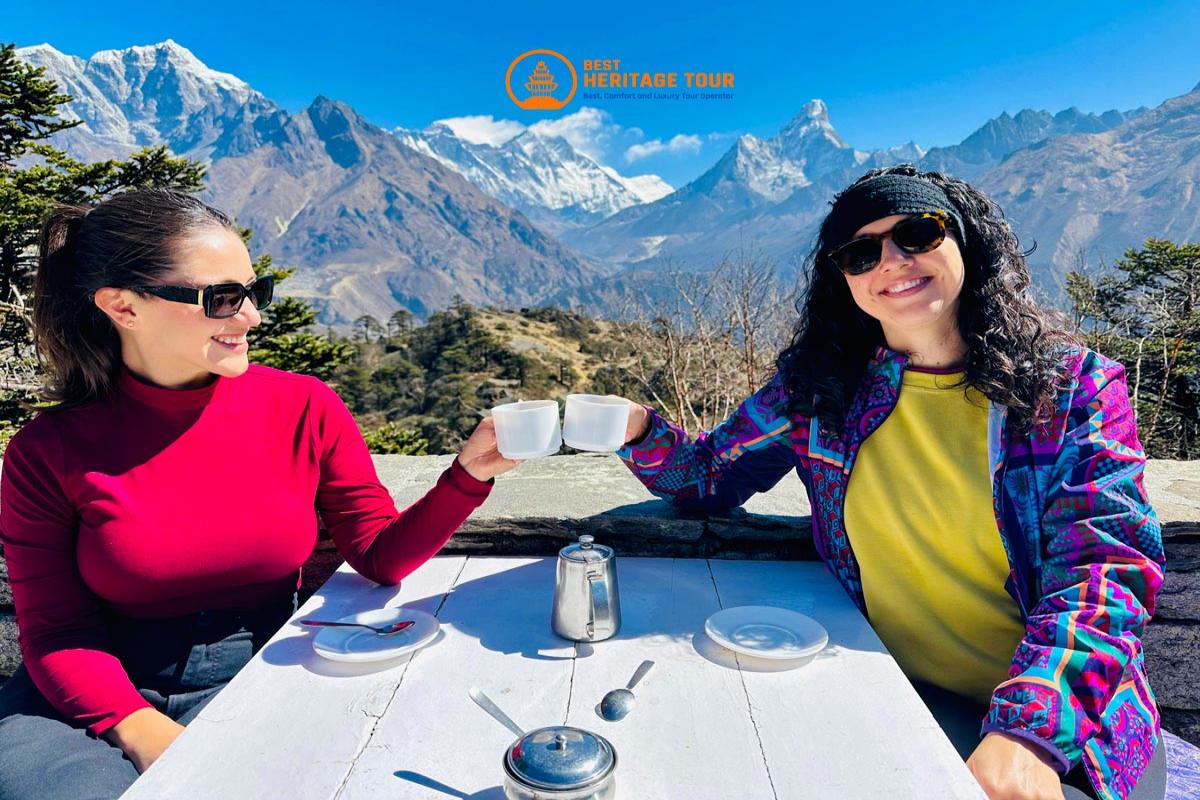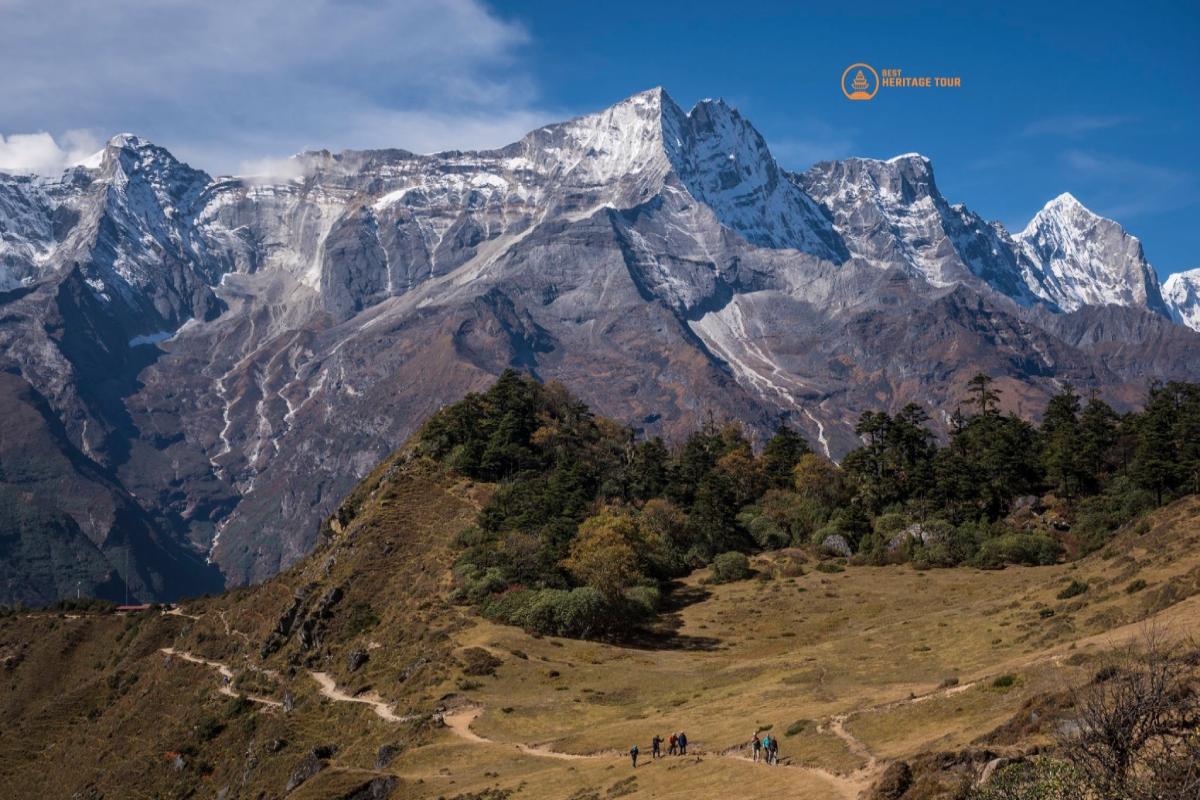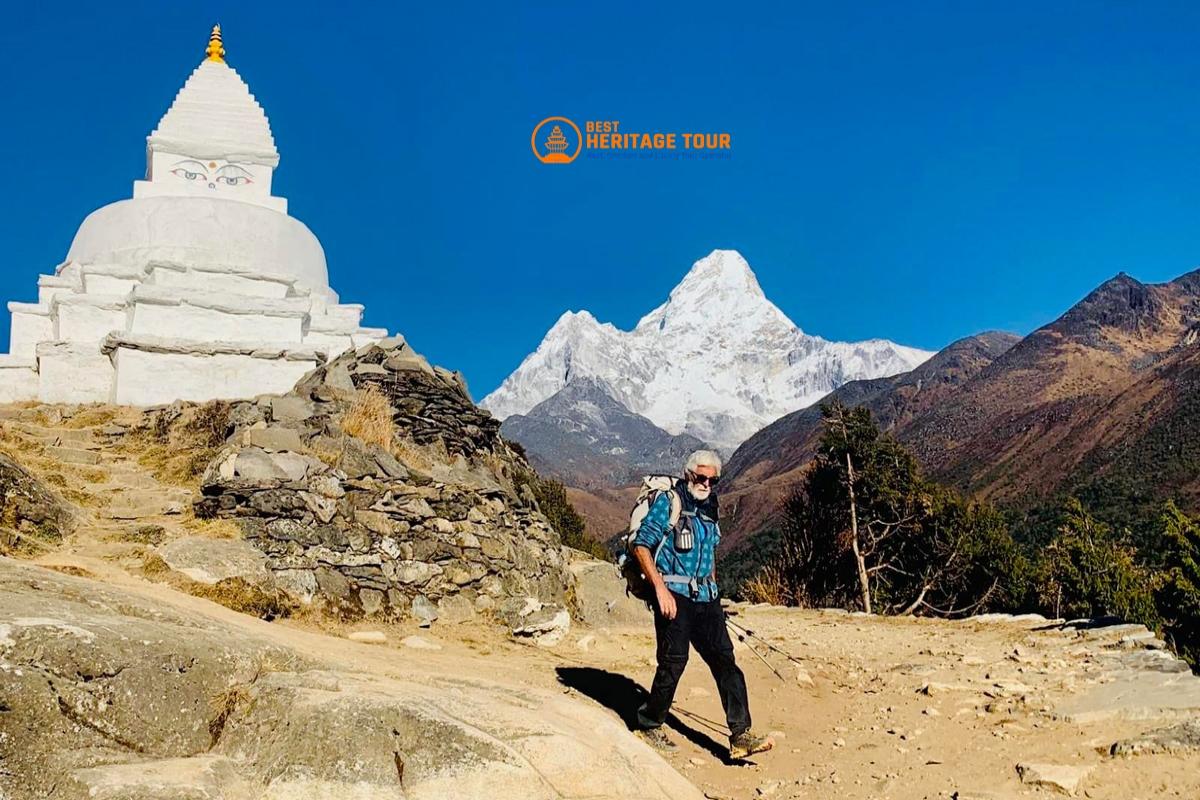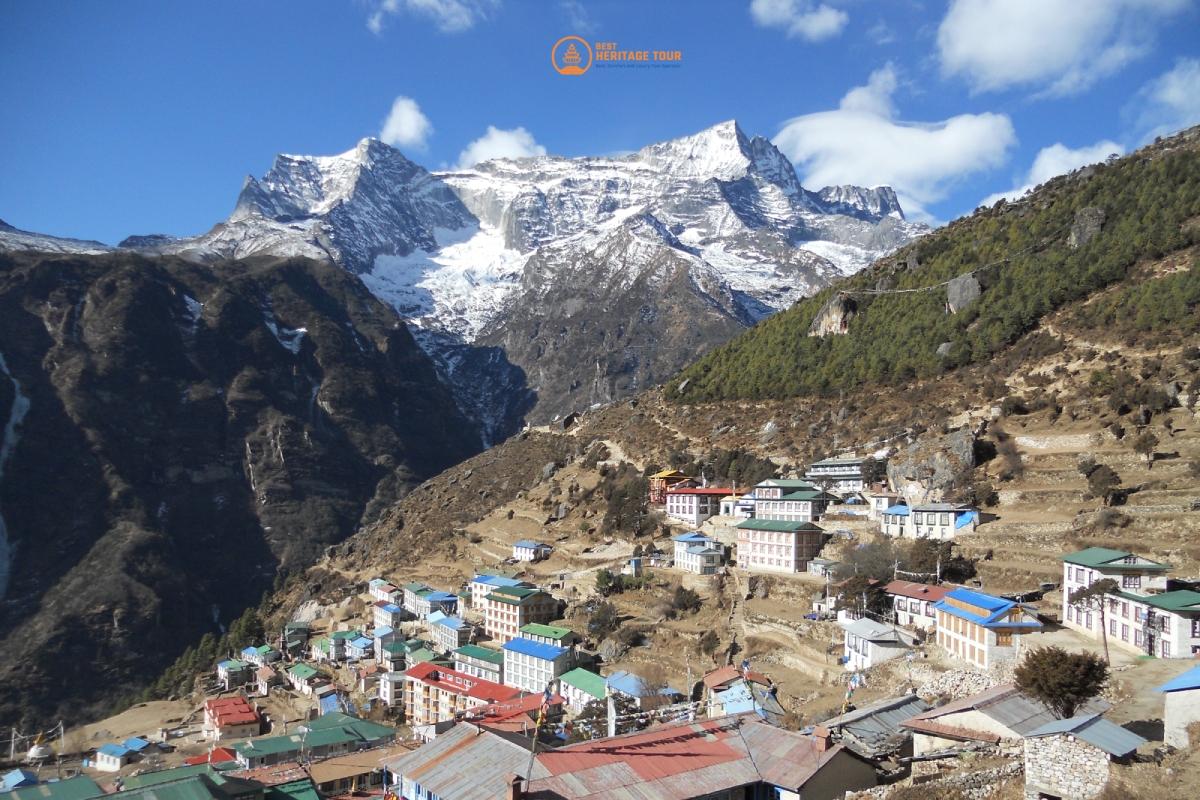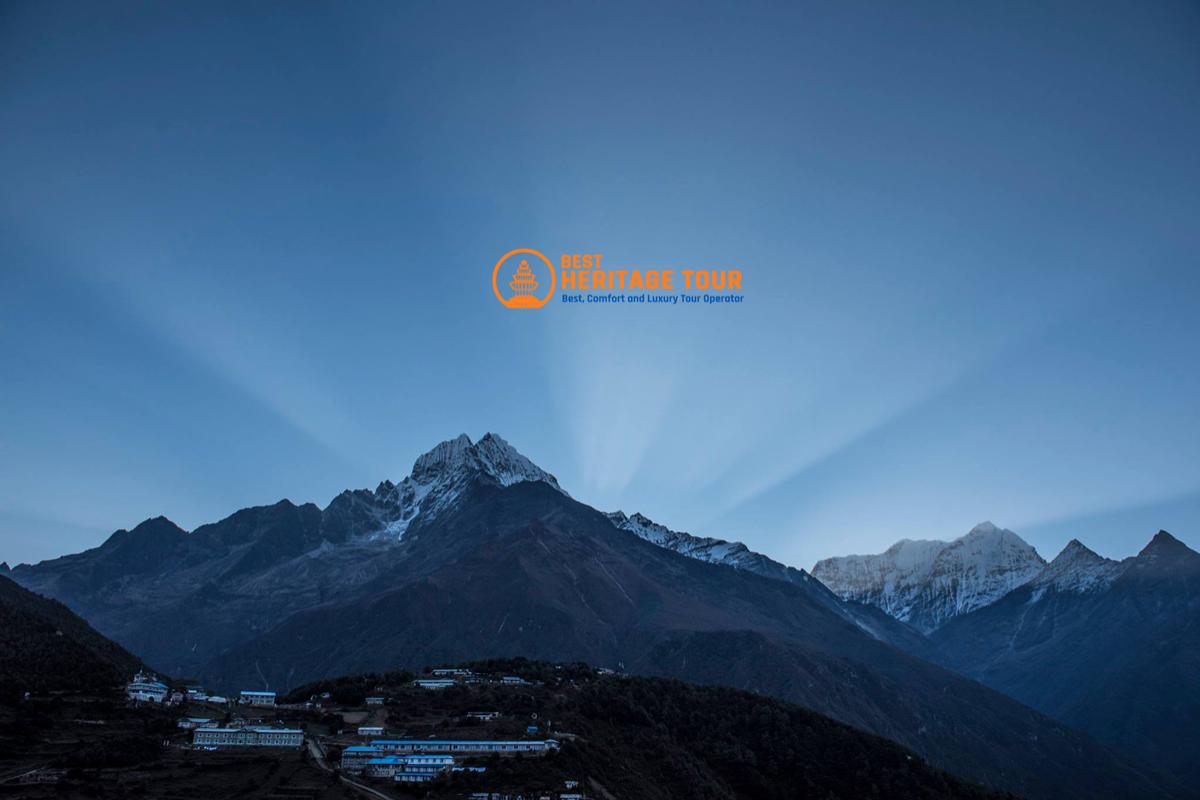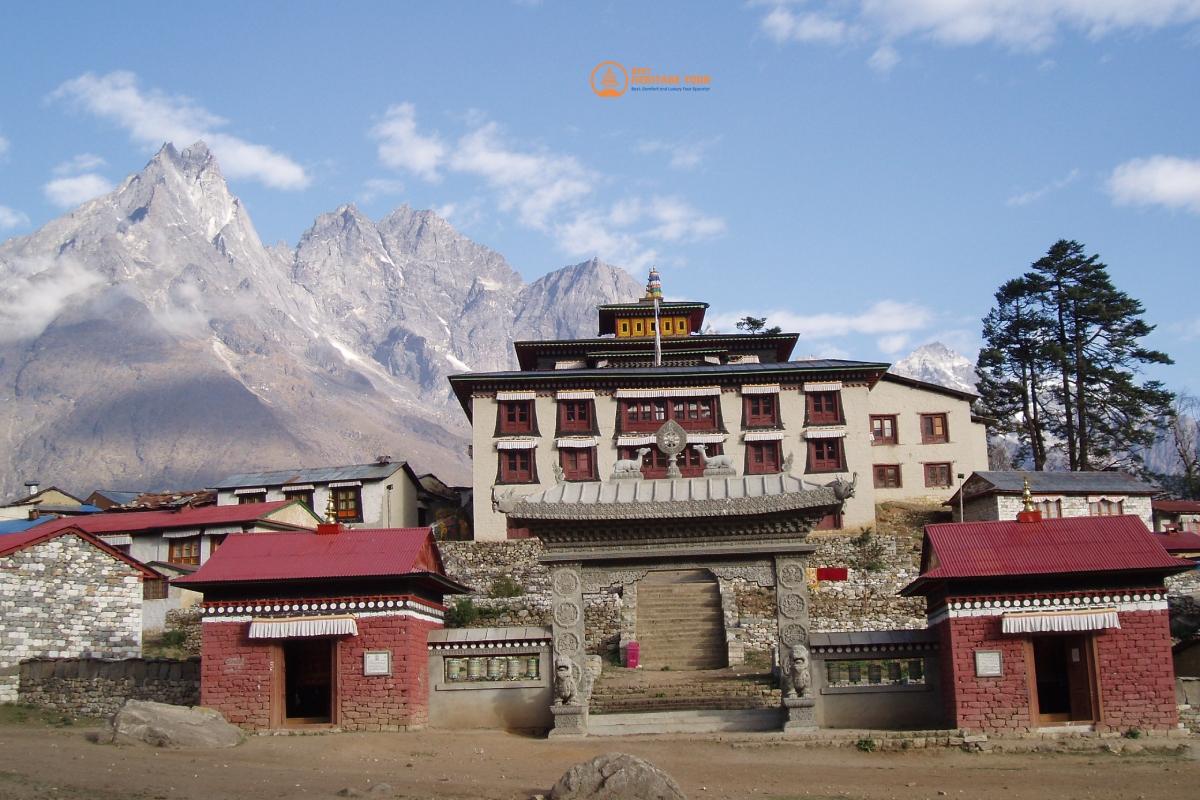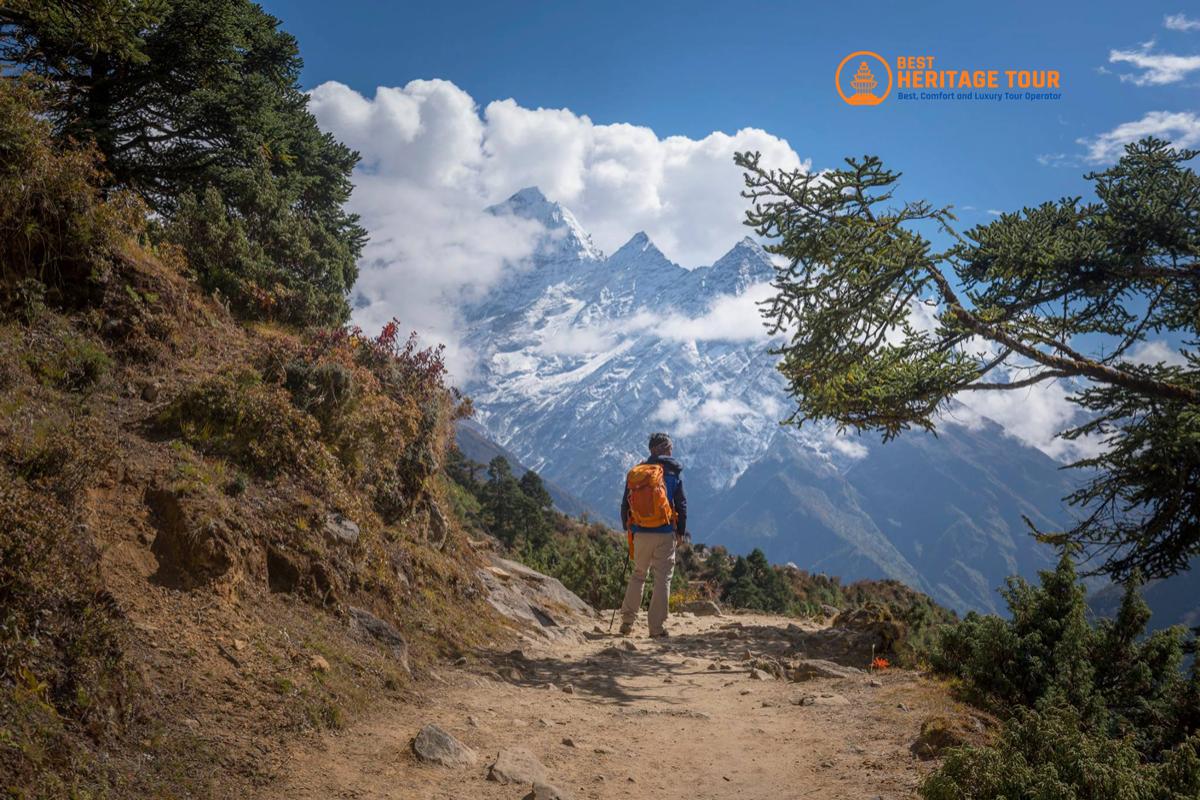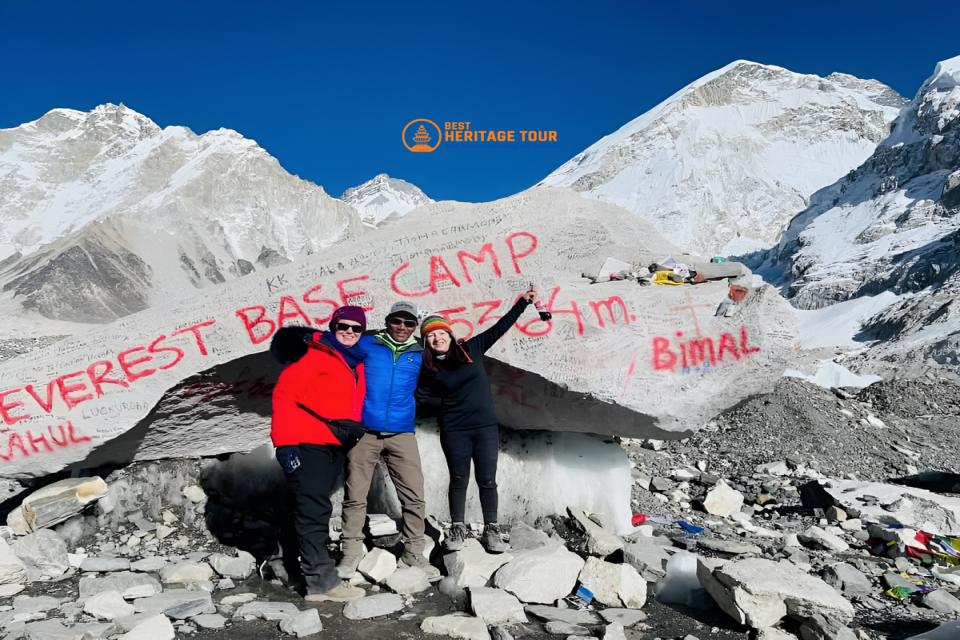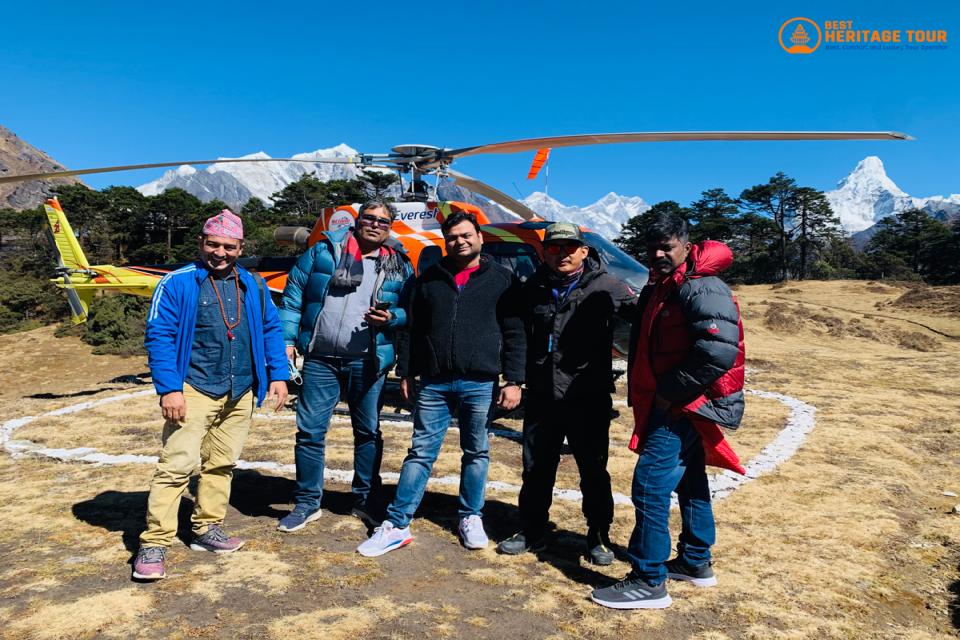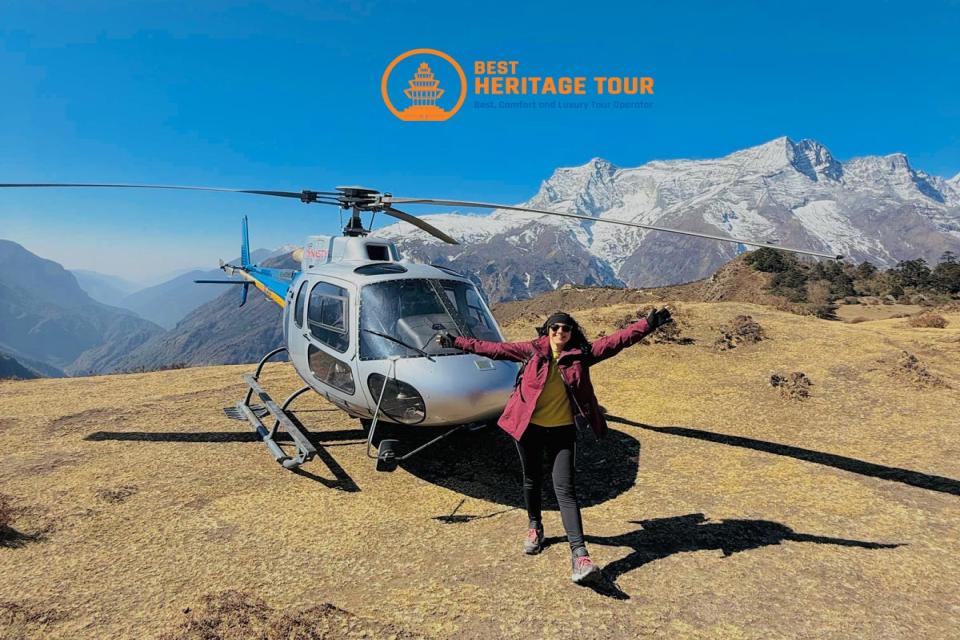Everest View Short Trek - 5 Days
Insight on Everest View Short Trek
The Everest View Trek is a short yet thrilling adventure through Nepal’s Khumbu region, offering breathtaking panoramas of Everest, Lhotse, and Ama Dablam. Trekking through lush forests and vibrant Sherpa villages, you’ll experience the region’s rich culture and warm hospitality. The journey peaks at Everest View Hotel (3,880m), where the world’s highest peaks feel within reach. With moderate trails and mesmerizing landscapes, this trek is perfect for those seeking an exhilarating Himalayan experience without extreme altitude challenges.
Trip at a Glance
Key Highlights
- Enjoy stunning views of Mount Everest (8,848 m) and surrounding peaks like Ama Dablam, Lhotse, Kondeli, and Kusum Kanguru.
- Explore Namche Bazaar, a vibrant Sherpa town with bustling markets, monasteries, and rich cultural traditions.
- Visit traditional Sherpa villages Khumjung and Khunde, including Khumjung Monastery and the legendary Yeti skull.
- Trek through Sagarmatha National Park, spotting wildlife like snow leopards, musk deer, and colorful alpine birds.
- Immerse yourself in Sherpa culture, local rituals, and mountaineering traditions.
- Experience Syangboche Airport and the Everest View Hotel for panoramic Himalayan vistas.
Benefits of Booking Everest View Trek with Best Heritage Tour
- Free airport to hotel transfer on arrival and departure.
- Personalized online trip discussion after booking to plan your adventure.
- High-altitude safety measures including frequent blood oxygen monitoring and a well-equipped medical kit.
- Easy and secure booking and payment system for convenience.
- Stay connected via email, WhatsApp, Facebook, Viber, Skype, and Zoom.
- 24/7 phone support (+9779851149197 / +977-9810043046) throughout the trek.
- Sleeping bags and down jackets provided if needed.
- Free excess baggage storage and a duffel bag for porters to carry your gear safely.
Trip Overview
The Everest View Trek is a short, accessible, and highly rewarding trek in the heart of the Khumbu region, designed for travelers who want to experience the grandeur of the Himalayas without undertaking a long or strenuous expedition. Starting with a scenic flight from Kathmandu to Lukla, trekkers are immediately immersed in breathtaking views of snow-capped peaks and deep Himalayan valleys. The short hike from Lukla to Phakding introduces you to the region’s serene landscapes and gives you a gentle start to your adventure.
From Phakding, the trek continues to the vibrant Sherpa town of Namche Bazaar, the cultural and administrative hub of the Everest region. Here, trekkers can explore bustling markets, visit ancient monasteries, and witness the rich Sherpa culture and traditions that have thrived for generations. Namche also provides an ideal acclimatization stop, allowing you to adjust comfortably to the moderate altitude while enjoying the surrounding scenery.
The highlight of the trek is a visit to the Everest View Hotel, offering unparalleled panoramic views of Mount Everest (8,848 m), Ama Dablam, Lhotse, and other Himalayan giants. The short hiking days ensure a comfortable pace, giving ample time to soak in the scenery, take photographs, and explore the surrounding Sherpa villages such as Khumjung and Khunde, which are renowned for their monasteries, local crafts, and welcoming communities.
The trek concludes with a return hike to Lukla and a scenic flight back to Kathmandu, bringing an end to a memorable and culturally rich Himalayan experience. Though short and moderate in difficulty, the Everest View Trek offers a perfect combination of breathtaking mountain vistas, cultural encounters, and comfortable trekking, making it an ideal choice for families, beginners, and travelers seeking an unforgettable Himalayan adventure in just a few days.
Online Trip Discussion
The online meeting will clear all your doubts regarding the trek, including what you need to bring for the trek (Equipment Checklist), detailed itinerary, and precautions to take along the way. Once your booking is complete, you will receive an email with: Date and time available for the trekking meeting. Once all required documents are received, the online trekking meeting will be held.
What to Expect from Everest View Trek
1. Breathtaking Mountain Views
Trekkers will be treated to stunning panoramas of Mount Everest, Ama Dablam, Lhotse, and other towering Himalayan peaks. Iconic viewpoints, including the Everest View Hotel, provide unmatched photo opportunities and unforgettable vistas. The ever-changing scenery - from snow-capped peaks to deep valleys - makes every step of the trek visually captivating.
2. Sherpa Villages and Culture
The trek passes through Namche Bazaar, Khumjung, and Khunde, offering a chance to experience authentic Sherpa culture and traditions. Explore bustling local markets, visit ancient monasteries, and interact with the friendly Sherpa people to learn about their resilient lifestyle, mountaineering history, and spiritual practices.
3. Comfortable Trekking Experience
The trek is easy and suitable for all ages, with well-paced walking days that allow for relaxation and enjoyment. Accommodation in hotels and teahouses offers warmth, clean bedding, and a cozy atmosphere, while hearty Nepali meals provide the energy needed for each day’s journey.
4. Relaxation and Sightseeing
With short trekking distances each day, you have ample time for photography, exploring local villages, and soaking in the Himalayan beauty. The trek balances adventure, culture, and leisure, making it an ideal choice for travelers seeking a memorable yet accessible Himalayan experience.
ALTERNATIVE OPTIONS
The basic advantage of SHORT EVEREST VIEW TREK is that you can easily explore the Himalayan ranges including the highest peak Mt. Everest. This can be seen from day 2 and on day 3, when you reach the Everest View Hotel, it will be a fascinating day to explore the vast Himalayan ranges from an altitude of 3880 meters.
Hikers also have alternative options here. If you want to explore Mount Everest Base Camp (5364m) and Kala Patthar (5545m), you can take a helicopter from Namche Bazaar or Everest View Hotel for a day trip to Base Camp and fly back to Namche Bazaar, Lukla or Kathmandu on the same day.
This is an added benefit for travelers who don't have a long vacation or are afraid of high altitudes. Thus, you can explore Everest in different ways or even venture to the foot of Everest. For more information, contact us. Let us know and we will make the whole trip the best it can be.
Itinerary can be customized according to your time and interests.
Itinerary
Today your journey to see Everest starts. After breakfast, drive 10 mins to the airport and start your 30 mins flight to one of the most beautiful airports in the world, located between the Himalayas. Upon arrival in Lukla, enjoy the views for a few hours and get your body acclimatized to the steep altitude difference from Kathmandu.
From the first day, you'll enjoy a well-defined and scenic route downhill with views of Kusum Kangar (6,367m) and Buddhist temples, hanging flags, prayer wheels, and farmland and tea houses along the way. Finally, you will reach Phakding village, a small Sherpa village where you will receive great hospitality.
Today is a little more tiring than the first day, so after breakfast, you will walk a little downhill to cross the Phakding suspension bridge. After crossing the bridge, you will continue on a steep climb for nearly 3 hours until you reach the beautiful village of Monjo at the top of the hill. This village marks the start of Sagarmatha National Park.
It will take another 4 hours to reach Namche Bazaar. You will cross the hills with beautiful views of the Himalayas and cross the Dudh Kosi River on a long suspension bridge. You will reach Jolsale (2775m), the last village before Namche Bazaar. From Jolsare, you'll continue on a steady climb to Namche Bazaar, the capital of the Khumbu region. Namche Bazaar is the oldest settlement of the Sherpa community. It is now a beautiful Himalayan town with a specialist hospital, post office, ATMs and banks. Further up the hill, there is an army camp to keep watch and provide assistance to hikers and climbers when needed.
Once you reach this beautiful town, you'll enjoy some free time and get your first view of the mighty Himalayan peaks of Everest, Nuptse and Lhotse.
Today will be the most eventful day in terms of views. After a hearty breakfast, head uphill to take in stunning views of the Himalayas. As you ascend towards Syangboche (3750m/12303ft), follow a narrow path that leads to the Everest View Hotel. On the way, you can visit the National Park Museum, an army camp with amazing views. After passing a herd of yaks and possibly Himalayan tahr (wild goats) on the cliffs of the mountain, you will reach the Everest View Hotel.
This is one of the hotels at the top of the Himalayas in terms of altitude. Once you arrive here you will be treated to a spectacular 360 degree panoramic view of the snow-capped Himalayan ranges including the mighty Everest. Here you will enjoy a few hours of tea/coffee/drinks with breathtaking views and finally return to Namche Bazaar to explore the Sherpa Kutumsang village.
After breakfast, you will slowly descend, passing all the places you saw on the first day of your climb. You will pass through Monjo village and cross the Dudh Kosi River on a suspension bridge. You will arrive at Phakding village for lunch. Then, you will head to Lukla, enjoying views of farms and villages along the way.This concludes the day and it was a memorable and wonderful experience. So it is also a holiday.
Enjoy a wonderful evening today and share your experience with our team. Singing and dancing at the dance bar will also make your trip unforgettable. Thank your guide for their help and kindness and say goodbye, promising to meet again someday.
After breakfast, prepare for your domestic flight back to the capital city, Kathmandu. Upon arrival in Kathmandu, you will be picked up at your respective hotel in a private vehicle.The trip ends at the hotel.
What is included?
- Round trip flight to and from Lukla
- Private transportation from your hotel to the airport and drop off
- Accommodation in a Hotel or lodge during the trek on twin sharing basis
- Meals including Breakfast, Lunch & Dinner throughout the trek
- All necessary permits fees: Sagarmatha National Park Permits, Khumbu Pasang Lhamu Rural Municipality Permit
- An experienced English speaking government-registered trekkking guide
- Souvenir - Best Heritage Tour T-shirt & Purse
What is not included?
- International flight airfare
- Visa fee for Nepal
- Personal expenses such as: Wireless internet access, hot water showers, battery recharging facilities, and individual expenditures.
- Travel insurance
- Tips for guides and porters (recommended)
- Additional costs resulting from factors beyond our control, such as landslides, weather conditions, itinerary adjustments due to safety concerns, illness, changes in government policies, strikes, etc.
- All government taxes 13%, SSF, and 10% service charges
Route Map
Equipment
Clothing
-
Base Layers: Moisture-wicking thermal tops and bottoms.
-
Insulating Layer: Fleece or down jacket for warmth.
-
Outer Layer: Waterproof and windproof jacket and pants.
-
Trekking Pants and Shirts: Lightweight, breathable, and quick-drying.
-
Warm Hat and Gloves: Essential for cold mornings and evenings.
-
Sun Hat / Cap and Sunglasses: Protection against UV rays at high altitude.
-
Hiking Socks: Wool or synthetic, multiple pairs recommended.
-
Trekking Boots: Sturdy, waterproof, and well-broken-in for comfort on trails.
Essential Trekking Gear
-
Backpack (30-40L)
-
Trekking Poles
-
Water Bottle / Hydration System
Accessories
-
Headlamp / Flashlight
-
Sunscreen and Lip Balm
-
Personal Toiletries (Toothbrush, toothpaste, wet wipes, hand sanitizer, Towel, etc.)
-
Camera / Smartphone
-
Snacks / Energy Bars
-
Power Bank / Extra Batteries
Trip Info
Best Time for Everest View Trek
The Everest View Trek can be undertaken throughout the year, offering stunning mountain vistas and cultural experiences in every season. However, the best periods are spring (March to May) and monsoon (late September to November). During these months, the skies are generally clear, temperatures are moderate, and the views of Mount Everest, Ama Dablam, and surrounding peaks are at their sharpest.
-
Spring (March to May): The valleys and rhododendron forests bloom with vibrant colors, creating a scenic backdrop for your trek. Moderate temperatures and longer daylight hours make walking comfortable and enjoyable.
-
Autumn (Late September to November): After the monsoon, the skies are clear, providing crisp and unobstructed views of Everest and neighboring peaks. Cooler temperatures and dry trails make it the most popular season for trekkers.
-
Monsoon (June to early September): Trekking is possible but more challenging due to heavy rainfall, slippery trails, and occasional reduced visibility.
-
Winter (December to February): This season offers fewer trekkers and snow-dusted landscapes, though temperatures are colder, especially at higher altitudes.
For the best combination of weather, visibility, and comfort, spring and autumn are ideal for a safe and memorable Everest View Trek.
Permits Required for Everest View Trek
For Everest View trek, two permits are required for safety, conservation, and support of local communities. Best Heritage Tour arranges all permits for a smooth, hassle-free experience.
-
Sagarmatha National Park Permit: Required for trekking in the Khumbu region, including Everest View and surrounding trails. It helps protect wildlife, forests, and cultural heritage.
-
Khumbu Pasang Lhamu Rural Municipality (KPLRM) Permit: Mandatory for trekking through villages and trails under KPLRM, supporting local development and trail maintenance.
Trekkers need to provide a scanned copy of a valid passport (minimum six months’ validity) and two passport-sized photos. Best Heritage Tour will handle the applications and provide the permits before the trek. Carry them along, as authorities may check at checkpoints.
Accommodation & Meals
During the Everest View Trek, accommodation is provided in a mix of hotels and teahouses across Phakding, Namche Bazaar, and Lukla. In Namche and Lukla, hotels offer comfortable rooms with clean bedding, basic amenities, and a relaxing environment to rest after a day of trekking. In Phakding, cozy teahouses provide a warm and homely atmosphere, allowing trekkers to experience authentic Himalayan hospitality while enjoying the surrounding mountain scenery.
Meals are served three times a day: breakfast, lunch, and dinner - featuring traditional Nepali dishes such as dal bhat, fresh vegetable curries, soups, noodles, and momos. The meals are nutritious and energizing, keeping trekkers well-fueled for each day’s journey. In addition to traditional meals, trekkers have the option to taste other cuisines at their own expense, as a variety of dishes are available in lodges and hotels along the trek.
Physical Fitness
The Everest View Trek is an easy and accessible trek, suitable for trekkers of all ages and fitness levels. Unlike longer or high-altitude expeditions, this trek involves moderate walking on well-marked trails with gradual ascents, making it ideal for beginners, families, and those seeking a less strenuous Himalayan experience.
No technical climbing skills are required, though basic stamina and a comfortable walking pace will enhance your enjoyment. Regular breaks along the route allow for rest, acclimatization, and sightseeing, ensuring that everyone can appreciate the stunning mountain views, Sherpa villages, and local culture without feeling rushed or exhausted.
Health & Safety
The Everest View Trek is an easy and accessible trek, but health and safety remain important. With moderate altitudes (up to around 3,880 m at Everest View), the risk of altitude sickness is low, though trekkers should still pace themselves, stay hydrated, and rest as needed. Proper clothing, layered gear, and adequate rest help prevent fatigue and cold-related issues.
Best Heritage Tour ensures your safety with experienced guides, carefully planned itineraries, and reliable accommodations. Lodges and hotels are selected for cleanliness and comfort, and 24/7 phone support is available for emergencies. By following the guides’ advice and maintaining a steady pace, trekkers can enjoy a safe, stress-free, and memorable Himalayan experience.
Travel Insurance
Travel insurance is recommended for the Everest View Trek to ensure peace of mind throughout your journey. Even though the trek is relatively easy and at moderate altitude, insurance should cover medical emergencies, high-altitude trekking, and evacuation in case of unexpected situations. Best Heritage Tour advises trekkers to have a policy that protects against unforeseen events so you can fully enjoy the trek, the breathtaking mountain scenery, and Sherpa cultural experiences without worry.
Visa for Nepal
All travelers (except Indian citizens) require a Nepal tourist visa to join the Everest View Trek. Visas are easily obtained on arrival at Tribhuvan International Airport in Kathmandu or at select land border points. You will need a passport valid for at least six months, fill out the visa form, provide a passport-sized photo, and pay the visa fee for 15, 30, or 90 days depending on your travel plans. You can also apply online in advance through the official Nepal Immigration website to save time.
Booking & Payments
To confirm your Everest View Trek, a 10% deposit of the total price is required at the time of booking, with the remaining balance payable upon arrival in Nepal before the trek begins. Payments can be made via bank transfer, credit card, or cash (credit cards may include additional charges). Group discounts and private departures can also be arranged. Detailed cancellation policies are provided before booking or one can see our Terms & Condition.
Last Minute Booking
While advance booking is recommended, Best Heritage Tour accommodates last-minute bookings. For these, full payment (100%) is required at least 24 hours before departure. We operate trekking tours year-round, but delays caused by weather or unavailable accommodations are beyond our control. For last-minute bookings, contact +977-9851149197 / +977-9810043046 or email info@bestheritagetour.com / bestheritagetour@gmail.com.
Trip Extension
If you wish to extend your adventure, Best Heritage Tour offers options such as exploring nearby trekking routes such Everest Base Camp, cultural tours in Kathmandu Valley, or visiting Pokhara and Lumbini. The team will help customize your itinerary based on your interests, schedule, and fitness level, making your Himalayan experience longer and more memorable.
Review
Shortest way to view Everest with adventure
I just went on Everest view short trek with Best Heritage Tour and it was an amazing trek. This trek was the perfect way to view Everest with little touch of trekking. The views of...
View DetailAmazing trek in Everest Region
Quickest and best way to view Mt. Everest with a little adventure. Definitely a worthy trek to explore mountains and the Sherpa culture and tradition. Thank you to Best Heritage...
View DetailBest Trek with exploration of Sherpa culture
Best time in the mountains with Best Heritage Tour. Well managed and perfectly balanced itinerary. I got enough time to explore beautiful mountains and rich Sherpa culture in...
View DetailFAQ's
Yes, all our guides are fluent in English and many speak other languages. This facilitates clear communication and enhances your overall experience.
Most trekking guides in Nepal speak basic to advanced English, which is enough for general communication about trekking and safety precautions. Some speak more fluent English, which will improve your overall trekking experience.
Yes, most visitors need a tourist visa to enter Nepal. A visa can be obtained on arrival at Tribhuvan International Airport in Kathmandu or applied for in advance at a Nepalese embassy or consulate.
Yes, you will need two passport-sized photos for both the visa application and the trekking permits, so it's a good idea to bring extra copies just in case.
You'll need a valid passport (with at least six months validity), a passport-sized photo, and the visa fee (which varies depending on the duration of stay).
To obtain the RAP, you’ll need:
- A valid passport.
- A Nepal visa.
- Travel insurance.
- Two passport-sized photos.
- A letter from your trekking agency detailing your itinerary and the names of the guide and group.
Yes, it’s possible to extend your visa if you wish to stay longer in Nepal. Extensions can be processed at the Department of Immigration in Kathmandu or Pokhara, but you should apply before your current visa expires.
You can exchange US dollars or Euros for Nepalese rupees upon arrival, but we recommend carrying cash in the local currency for most transactions outside of major cities.
Yes, teahouses are generally safe and many hikers have had good experiences with them, but it's wise to use common sense, lock up your valuables, and choose a reputable establishment recommended by your guide.
To ensure you are comfortable while trekking, your backpack should ideally weigh 10-15% of your body weight, usually around 10-15 kg (22-33 lbs).
Physical preparation is essential to a successful trekking experience. Begin an exercise program 6-8 weeks before your hike that focuses on:
- Aerobic exercise: Activities such as running, cycling, and swimming to improve endurance.
- Strength training: Leg, core, and upper body exercises to increase strength.
- Practice hiking: Fill up your backpack and go on a short hike to simulate trekking conditions.
Hiring porters is not mandatory but highly recommended. Carriers allow you to carry heavy loads and make the hike more comfortable. This also supports the local economy and creates jobs in the area.
It is important to stay hydrated while climbing. Bring a reusable water bottle and use water purification tablets or a filter if necessary. Pack energy-rich snacks such as nuts, energy bars and dried fruit to maintain your energy levels throughout the day.
Before any hike, test your equipment on a training hike to make sure everything fits well and works properly. Ensure that you break in your trekking footwear to prevent blisters and discomfort.
Yes, we recommend that you have a small first aid kit with some basic items such as adhesive tape, disinfectant wipes, painkillers, altitude sickness medication, and personal medications.
Yes, you can rent trekking gear in Kathmandu and other major cities. However, we recommend that you check the quality and suitability of the equipment before renting.
Pay attention to your body's signals, especially when fatigue sets in.
- Take a break: Take a break when necessary and find a comfortable place to sit and relax.
- Stay hydrated: Drink water regularly and eat snacks to replenish your energy.
- Inform your tour guide: Should you begin to feel unwell, it is important to communicate this to your tour guide. They can assist in modifying the pace and itinerary as needed.
Training at altitude helps your body adapt to lower oxygen levels, which can be beneficial for hiking. However, it is not absolutely necessary. Being in good cardiovascular condition can also prepare you for the conditions.
In the event of altitude sickness, it is vital to descend to a lower elevation immediately and take time to rest. Drinking plenty of fluids and taking over-the-counter medications (such as ibuprofen) can help reduce symptoms. See a doctor if symptoms persist.
Consult your doctor for individual vaccination recommendations. Common vaccinations climbers should consider include:
- Tetanus
- Hepatitis A and B
- Typhoid
- Rabies (if in contact with wild animals)
The main health risks while trekking include:
- Altitude sickness: occurs when you ascend too quickly without adequate acclimatization, causing symptoms like headaches, nausea, and fatigue.
- Dehydration: Insufficient fluid intake can cause fatigue and headaches.
- Injuries: Falls and slips on uneven surfaces can cause sprains and fractures.
Trekkers are strongly encouraged to take out travel insurance. Make sure your insurance covers high altitude hiking, medical evacuation and trip cancellation. This gives you peace of mind and financial protection in case of emergencies or unexpected events.
In case of emergency:
- Keep calm: Staying calm helps you make better choices.
- Contact your tour guides. They are trained to deal with emergencies and know what is best.
- Use communication devices: If necessary, you can use satellite phones and emergency transmitters for communication in remote areas.
In remote and secluded areas, maintaining a sense of connection can prove to be quite challenging.
- Cellular Network: Most areas along the trek have good mobile coverage, especially in larger villages such as Samagaon. However, signals can be unreliable.
- Wi-Fi Availability: Some teahouses offer Wi-Fi, but the connection can be slow and there may be a charge.
- Satellite Phone: If traveling to an area without cell coverage, consider renting a satellite phone in case of emergency.
Yes, Nepal offers an electronic visa (e-visa) that can be applied for online before arriving. This process enables you to bypass the visa queue upon arrival at the airport. After completing the online application, you can get your visa stamped on arrival.
The tourist visa fees are as follows:
• 15 days: USD 30
• 30 days: USD 50
• 90 days: USD 125 Note that these fees are subject to change, so check the current visa fees before your trip.
No, previous trekking experience is not mandatory. However, a good level of physical fitness is necessary, as the trek involves walking for 5-7 hours per day and ascending to high altitudes.
Most teahouses in remote areas do not allow online reservations. However, during peak seasons, guides or trekking agencies can help secure rooms in advance. It’s recommended to have a guide manage accommodations, especially in crowded seasons.
Yes, teahouses usually provide blankets, but they may not always be warm enough at high altitudes. Bringing your own sleeping bag rated for cold weather is essential.
Yes, it's recommended to bring your own trekking poles. They provide essential support during steep ascents and descents, and are particularly helpful for managing balance on rough terrain.
You should bring sturdy, waterproof trekking boots with good ankle support. Ensure they are well broken-in before the trek to avoid blisters or discomfort.
Start a fitness routine several months before the trek to gradually build strength and endurance. Even light to moderate exercise a few times a week can help condition your body. You can also opt for shorter and easier treks first to gain experience.
Yes, waterborne diseases are a concern in remote areas. Always drink purified or boiled water. Bring water purification tablets or a portable water filter to treat water from local sources.
Yes, if you wish to extend your stay, you can apply for a visa extension at the immigration office in Kathmandu or Pokhara.
While Nepali is the primary language, most staff members in lodges speak English, and some may even speak other languages. Communication should not be an issue for international tourists.
This trek is a brief yet stunning journey to the Everest region, combining breathtaking mountain vistas with a cultural experience through Nepal's heritage sites. Over five days, trekkers witness the iconic Mount Everest and explore traditional Sherpa villages.
Choose the Best Heritage Tour for a perfect mix of trekking and cultural exploration. It combines stunning Everest views with visits to Kathmandu's UNESCO World Heritage Sites in just five days. Ideal for beginners and families, this tour balances nature and history, offers professional guides, and provides a personalized, time-efficient experience. You get the best of both worlds—Himalayan beauty and Nepal’s rich heritage!
The Everest Base Camp Trek is a longer, more challenging journey that takes around 12-14 days, leading trekkers to the foot of Mount Everest at 5,364 meters. The Short Everest View Trek, on the other hand, is a 5-day trek offering a glimpse of Everest without reaching the base camp, focusing more on scenic views and cultural experiences at lower altitudes.
The trek itself spans five days, including sightseeing in Kathmandu’s UNESCO World Heritage sites and a scenic flight to Lukla.
The trekking distance ranges between 20-30 kilometers in total, with about 4-6 hours of trekking each day.
While it is possible to trek independently, it is highly recommended to hire a licensed guide for navigation, cultural insights, and safety in remote areas.
The best seasons are spring (March to May) and autumn (September to November), when the weather is stable, the skies are clear, and temperatures are moderate.
Temperatures vary from 10°C to 20°C during the day and can drop to as low as -10°C at night in higher elevations.
Winter (December to February) can be cold, with daytime temperatures between -5°C to 10°C. However, the skies are often clear, offering great mountain views, but the nights can be extremely cold.
Rain is more common during the monsoon season (June to August), so it’s important to carry a waterproof jacket, and rain cover for your backpack, and be prepared for muddy trails.
Visa processing usually takes 15-30 minutes, depending on the number of arrivals. E-visas are also available to save time upon arrival.
Yes, breakfast, lunch, and dinner are included during the trekking days. However, meals during your stay in Kathmandu may not be covered, depending on the package.
Personal expenses, tips for guides and porters, travel insurance, and additional beverages or snacks are not included. Additionally, you may encounter charges for Wi-Fi and hot showers in some teahouses.
Yes, it is crucial to have travel insurance that covers trekking up to 3,000 meters, medical emergencies, and emergency evacuations.
Yes, this trek is relatively easy compared to other Everest region treks. This option is ideal for novices or individuals with constrained time.
Yes, solo travelers can enjoy the trek. However, joining a group or hiring a guide adds security and a more enriching experience.
In Kathmandu, trekkers stay in standard hotels, while along the trek, teahouses provide basic but comfortable lodging. Rooms may be shared and bathrooms are often communal.
Teahouses offer a variety of meals, ranging from traditional Nepali dishes like dal bhat (lentils and rice) to international options such as pasta, noodles, and soups. Meals are typically simple, hearty, and vegetarian, as fresh ingredients are harder to come by at higher altitudes.
Rooms in teahouses are usually basic and shared. Single rooms are available at an additional cost, but availability may be limited, especially during peak seasons.
Teahouses usually do not provide heating in the bedrooms. However, the dining area may have a stove, fueled by wood or yak dung, where trekkers can warm up during mealtimes. Make sure to dress warmly and bring a quality sleeping bag for colder nights.
Wi-Fi is accessible in the majority of teahouses; however, it frequently operates at a slow speed and incurs an additional fee. It’s recommended to carry a local SIM card with a data plan for more reliable internet access
Yes, but there is usually an additional charge at most teahouses. Hot water is usually solar-powered or gas-heated.
Essential items include trekking boots, a warm jacket, layers of clothing, a sleeping bag, and a daypack. It’s advisable to bring a reusable water bottle, a headlamp, and a trekking pole.
Yes, trekking gear can be rented in Kathmandu, including sleeping bags, jackets, and trekking poles.
Trekking poles are advisable for enhancing stability on irregular surfaces and minimizing knee strain during downhill sections.
Teahouses provide blankets, but temperatures can drop at night, so it’s a good idea to bring a sleeping bag rated for cold weather, or you can rent one in Kathmandu.
A moderate level of fitness is recommended as you'll be trekking in mountainous terrain for 4-6 hours daily. Regular exercise and some preparation hikes before the trip will be beneficial.
It’s advisable to engage in regular cardio exercises like walking, hiking, or jogging a few weeks before the trek to build endurance. Strengthening leg muscles and improving balance will also be beneficial.
If you have any health issues, it is essential to seek advice from your physician prior to embarking on the trek. Trekking in the mountains involves physical exertion, so it’s important to be in good health.
It’s advisable to be up-to-date on routine vaccinations, including hepatitis A and typhoid. Talk to your doctor about the vaccinations you need for Nepal.
Altitude sickness can occur above 3,000 meters, but this trek remains below that altitude. Nonetheless, it is crucial to maintain proper hydration, ascend gradually, and heed the signals your body provides.
While basic medical services can be found in larger villages such as Namche Bazaar, serious health concerns may require helicopter evacuation.
Boiled or filtered water is available in teahouses, but you can also carry water purification tablets or a filtration system to ensure safe drinking water from streams.
Yes, travel insurance that covers emergency evacuation, accidents, and medical issues is highly recommended.
There are not many ATMs in the Everest region, so it's a good idea to have enough cash for your personal expenses during the trek.
Yes, but charging electronic devices may come at an extra cost, especially in the higher villages. It's smart to have a portable power bank with you.
The trek begins with a 30-45 minute scenic flight from Kathmandu to Lukla. Lukla acts as the entry point to the Everest region.
Flights can be delayed or canceled due to weather conditions, especially during the monsoon season. It’s a good idea to allocate an extra buffer day in case of flight disruptions.
In case of flight cancellations due to weather, you can wait for the next available flight or opt for a helicopter ride at an additional cost. Flexibility in your schedule is recommended.
Hot showers are available in some teahouses for an extra fee, but Wi-Fi is scarce and often comes with additional costs.
- Cardio: Running, swimming, or cycling 3-4 times a week can improve endurance.
- Leg Strength: Include exercises like squats, lunges, and hiking on hilly terrain to prepare your legs for the varied elevation gains.
- Endurance: Long walks with a backpack, gradually increasing your distance and weight, will help your body adjust to carrying a load for extended periods.
Choosing the best heritage tour provides an enriching cultural experience, blending education, comfort, and unique local interactions for unforgettable travel memories.
The majority of international flights arrive at Tribhuvan International Airport, which is located in Kathmandu. From this location, travelers can connect to Lukla to commence their trekking journey.
You typically need a valid passport, a completed visa application form, and a passport-sized photo. Payment can be made in cash or via card at the airport.
Yes, tourist visas are eligible for extension at the Department of Immigration located in Kathmandu. Ensure you have a valid reason and required documents for the extension.
If you wish to extend your stay in Nepal beyond your visa’s initial duration, you can do so by applying at the Department of Immigration in Kathmandu. Extensions are available for a maximum of 30 days, and it’s recommended to apply before your current visa expires. Best Heritage Tour can help you with the extension process if required during your Australian Camp Trek.

